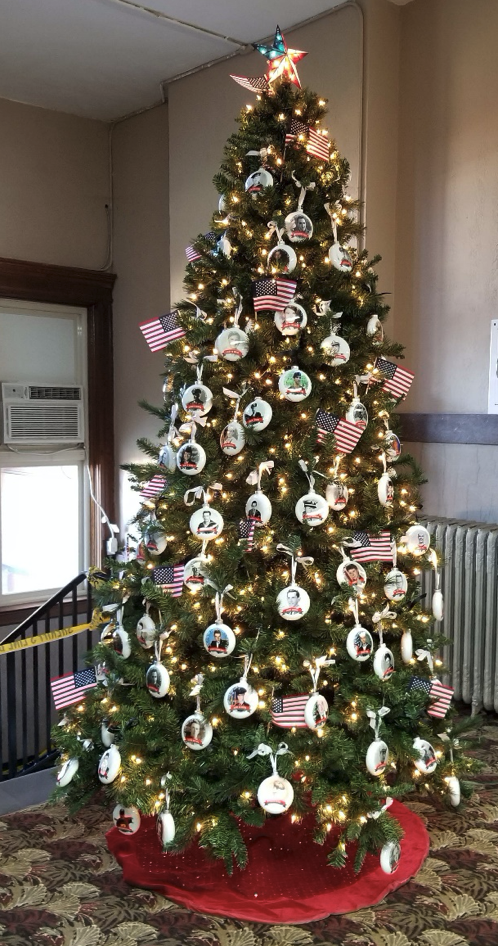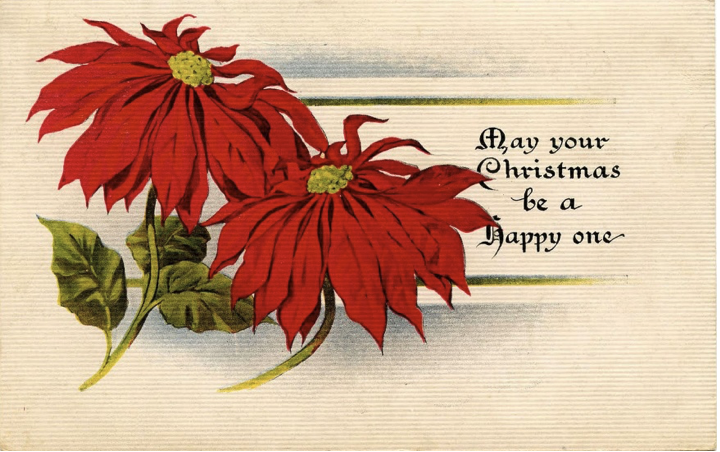Christmas Traditions
Part Two
As I said last week, Doddridge County, like most of America is deeply steeped in Christmas traditions. According to a Pew Research Center survey, 9 in 10 Americans celebrate Christmas. Many of the ways in which we celebrate Christmas dates back to 16th century Germany and even ancient Greece.
I continued to research these stories and the following results will explain just how these traditions came to be.

CHRISTMAS TREES – There are many myths regarding the origins of the Christmas. Some believe that Martin Luther, who catalyzed the Protestant Reformation, believed that pine trees represented the goodness of God. Others believe that in the 8th century Saint Boniface, who thwarted a pagan human sacrifice under an oak tree by cutting down that tree and a fir tree grew in its place. Its branches were said to represent Christ’s eternal truth. In some areas of the world the fir tree was cut down by Saint Boniface and hung upside down. This led to the tradition of trees being hung upside down to represent the Holy Trinity.
In 1419 Germany, a tree was decorated with apples, flour-paste wafers, tinsel, and gingerbread were tied to its branches with wool thread, straw, nuts, and pretzels.
Strasbourg, France (part of Rhineland at that time) was the site of the first Christmas tree market in the 17th century. In Germany, the word for Christmas tree is “Weihnachtsbaum”. The 1st decorated Christmas tree is recorded in that town during the 1605 Christmas season.
In America, the first Christmas tree dates back to the late 18th century and early 19th century. The pine tree is recorded to have been mentioned in North Carolina in 1786. A Moravian school for American Indians decorated a Christmas tree in their school with red pepper swags, cotton, moss, pecans, and popcorn.
The National Christmas Tree Association requests that consumers use real trees to support local economies. They state that real trees are grown in the U.S. and Canada, while many plastic trees are manufactured in China. They say that real trees are renewable resources and recyclable, while the artificial kinds could contain some non-biodegradable parts. So, fellow Americans, feel great about bringing that live tree into your home.

CANDY CANES – According to Smithsonian magazine, there are a lot of explanations regarding the candy cane.
There’s the one about how the white represents Jesus and the red his blood and the cane is really a J for Jesus. There are a lot of versions of this story out there. Snopes has some of them, including the most common retelling:
“A candymaker in Indiana wanted to make a candy that would be a witness, so he made the Christmas Candy Cane. He incorporated several symbols from the birth, ministry, and death of Jesus Christ.
He began with a stick of pure white, hard candy. White to symbolize the Virgin Birth and the sinless nature of Jesus, and hard to symbolize the Solid Rock, the foundation of the Church, and firmness of the promises of God.
The candymaker made the candy in the form of a “J” to represent the precious name of Jesus, who came to earth as our Savior. It could also represent the staff of the “Good Shepherd” with which He reaches down into the ditches of the world to lift out the fallen lambs who, like all sheep, have gone astray.
Thinking that the candy was somewhat plain, the candymaker stained it with red stripes. He used three small stripes to show the stripes of the scourging Jesus received by which we are healed. The large red stripe was for the blood shed by Christ on the cross so that we could have the promise of eternal life.
These Jesus celebrating candies were then, the story goes, handed out to good children in church or used as a form of identification among Christians when they were persecuted. None of this is true. First, candy canes were certainly not invented in Indiana, since the first reports of hard candy sticks (the precursor to candy canes) come from the 17th century, long before Indiana was even a glimmer in some secessionist’s eye.
And it turns out that white candy sticks were actually quite common at Christmas. One story says that they turned into J’s because one choirmaster bent them to look like a shepherd’s staff for children during the nativ
ity scene. There’s no evidence that that’s true either, of course. Today I Found Out writes, ” Given that it has been a time honored church tradition to try to associate as many Christmas season traditions’ “origin stories” as possible with Christianity, usually just for symbolism’ sake but often getting morphed into being believed as fact, color me skeptical on this one.”
In America’s introduction to Christmas candy canes is often traced to August Imgard, a German immigrant who’s credited with introducing the Christmas tree to Ohio in 1847. The National Confectioners Association, for instance, says that Imgard “decorated a small blue spruce with paper ornaments and candy canes.” But a 1938 article on a ceremony that honored Imgard’s contribution and included three generations of his family mentions a different kind of sweet:
Ornaments were made of paper, festooned in long chains by the younger members of the pioneer community. Kuchen baked according to a recipe sent from Bavaria by Imgard’s mother, hung upon the tree and served both as ornaments and tidbits. The cookies were colored with brown sugar and the family spent weeks baking them in quantities for the guests. Gilded nuts were other ornaments and inside the gilded shells were warm messages of greeting.
Red-and-white striped candy didn’t start showing up until around the turn of the century. But there is one thing that Christians can claim as their own, when it comes to the candy cane. It’s not the shape, or the stripes, but the machine that actually makes them into J’s. Here’s Today I Found Out again:
Father Keller was the brother-in-law of the aforementioned Bob McCormack. McCormack was having trouble at the time because about 22% of the candy canes produced by Bob and his crew were ending up in the trash, because they broke during the bending process. Keller’s machine automated this process and shortly thereafter was perfected by Dick Driskell and Jimmy Spratling, both of which worked for Bob McCormack. This made it so the candy canes came out perfect nearly every time.
So, while it’s unlikely Christians invented the candy cane, but they might have perfected it.”

CHRISTMAS WREATHS – From SANTA’S QUARTERS, I found these amazing stories about the history of the wreath:
“The word “wreath” comes from the Old English “writhan,” meaning “to twist.” Wreaths date back to the Persian Empire, ancient Egypt, and ancient Greece.
Christmas wreaths are also connected with the pagan holiday of Yule, marking the winter solstice.
Rome, too, had an annual midwinter celebration, called Saturnalia, during which they worshiped Saturn, who was the god of agriculture or sowing, from Dec. 17 through Dec. 23. For Saturnalia, Romans used holly wreaths as a form of decoration and also gave them as gifts.
Today, some religions use wreaths for purposes not associated with Christmas. Ramadan, for example, is a holy month observed by Muslims, and at the conclusion of Ramadan, the end of fasting is marked by a three-day celebration called Eid al-Fitr. Door wreaths are often displayed during this time.
But perhaps the most widespread and well-known use of wreaths comes in connection with Christmas and with Christianity, as their circular shape is said to symbolize eternal life and the unending love of God.
In the 16th century, the use of wreaths during Yule was adopted by Christians and became a custom in the form of Advent wreaths. These wreaths were traditionally made of evergreens, which also symbolize eternal life, holly oak, and red berries. The red berries and the thorny leaves of the holly oak represented the crown of thorns worn by Jesus and the drops of blood that they drew. The Advent wreath is meant to hold four candles, three purple and one pink. The first candle to be lit during Advent is meant to symbolize hope and is a purple one called the prophecy candle. On the second Sunday of Advent, another purple candle, called the Bethlehem candle, is lit. It symbolizes love to some and the hay-manger of Jesus to others. The pink candle, called the shepherd candle, represents joy, and is lit on the third Sunday of Advent. Peace is represented by the angel candle, which is the final purple candle and is lit on the fourth Sunday of Advent. Sometimes, a fifth, white candle is added to the center of the wreath. This is referred as the Christ candle, and it’s lit on Christmas Eve. These candles symbolize the coming of the light of Christ.
For some people, Christmas wreaths are not meant to be religious symbols but rather are strictly for decoration. Today, a wreath that’s hanging on one’s door at Christmas may symbolize the invitation of Jesus into one’s home, or it may be inviting the spirit of Christmas into the home along with good luck.”

POINSETTIAS – Poinsettias are native to Central America, especially an area of southern Mexico known as ‘Taxco del Alarcon’ where they flower during the winter.
The poinsettia was made popular by the first Ambassador from the USA to Mexico in 1825, Joel Roberts Poinsett (thus the name, Poinsettia!). Poinsett had some greenhouses on his plantations in South Carolina, and while visiting the Taco area in 1828, he became interested in the plants. He immediately sent some of the plants back to South Carolina, where he began growing the plants and sending them to friends and botanical gardens.
One of the friends to whom he sent plants was John Bartram of Philadelphia. At the first Philadelphia flower show, Robert Buist, a plantsman from Pennsylvania saw the flower and was probably the first person to have sold the poinsettias under their botanical, or Latin name, name ‘Euphorbia pulcherrima’ (it means, ‘the most beautiful Euphorbia’). They were first sold as cut flowers. It was only in the early 1900s that they were sold as whole plants. It is thought that they became known as Poinsettia in the mid-1830s when people found out who had first brought them to America from Mexico.
There is an old Mexican legend about how Poinsettias and Christmas come together, it goes like this:
One Christmas Eve, Maria and Pablo walked to the church for the evening’s services, wishing desperately that they had a gift to bring. Just then, a soft glowing light shone through the darkness, and the shadowy outline of an angel appeared above them.
Maria and Pablo were afraid, but the angel comforted them, instructing them to pick some of the short green weeds that were growing by the road. They should bring the plants to the church, the angel explained, and place them near the manger as their gift to the Baby Jesus. Then just as quickly as she had appeared, the angel was gone, leaving Maria and Pablo on the road looking up into the dark sky. Confused but excited, the children filled their arms with large bunches of the green weeds and hurried to the church.
When the children entered the church, many of the villagers turned to stare. As Maria and Pablo began placing the weeds around the manger,
some of the villagers laughed at them. “Why are those children putting weeds by the manger?” they asked each other. Maria and Pablo began to feel embarrassed and ashamed of their gift to the Baby Jesus, but they stood bravely near the manger, placing the plants on the soft hay, as the angel had instructed.
Suddenly, the dull green leaves on the tops of the plants began to turn a beautiful shade of red, surrounding the Baby with beautiful blooms. The laughing villagers became silent as they watched the green plants transform into the lovely star-shaped crimson flowers we call poinsettias. As they watched the weeds bloom before their eyes, Maria and Pablo knew they had no reason to be ashamed anymore. They had given the Baby Jesus the only gift they could–and it was the most beautiful gift of all.
Today, poinsettias are a traditional symbol of Christmas, thanks to young Maria and Pablo and their special gifts to the Baby Jesus.
God Bless and Merry Christmas
Patricia Richards Harris

